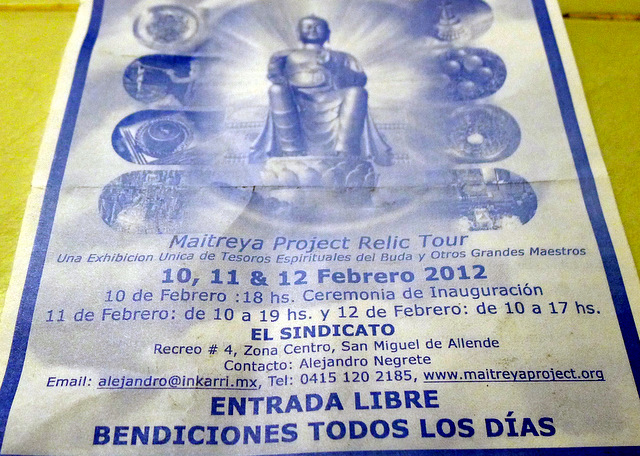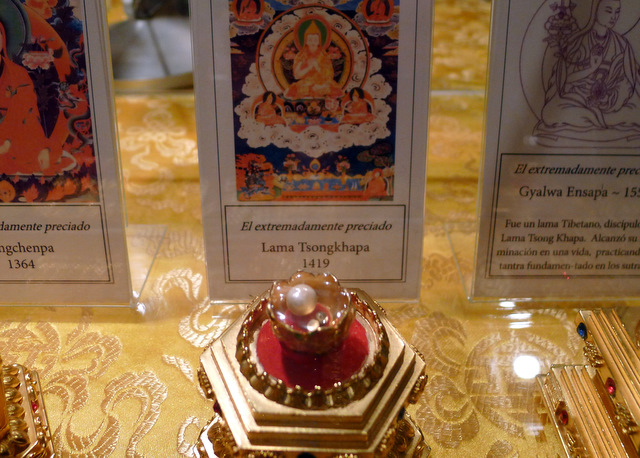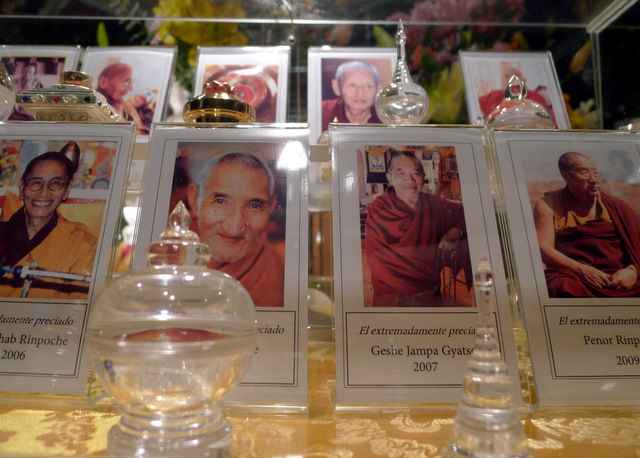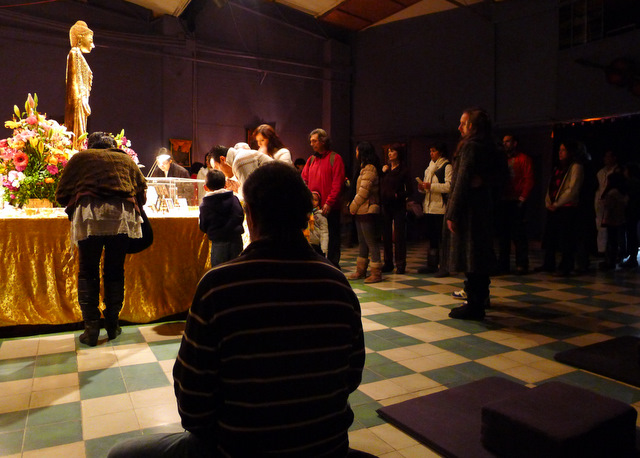
Just one day after the ghastly, gruesome yet thoroughly Mexican Museo de las Momias (Mummy Museum) in Guanajuato, San Miguel de Allende presented the remains of more enlightened souls in a less macabre exhibit. I learned of the Maitreya Project during today’s Unitarian-Universalist service in town, which I happily attend with my mom and Ray when visiting them.

The Maitreya Project plans to erect a 500 foot statue of the Loving Kindness Buddha where the enlightened achieved final nirvana upon his death in Kushinagar, India. The Maitreya Buddha is the successor to the historical Siddhartha Gautama Buddha, who will arrive on earth when Dharma is all but lost in our world.
The introductory video presented renditions of the site with the towering 50-story Buddha, a magnificent (and expensive at USD 195M) stupa to honor one of the most important sites in Buddhism. I was impressed with the project’s goals other than the statue: construction employs local labor and suppliers, and tourist revenue will continue long after the build is complete, contributing greatly to the local economy; the facilities will be 100% powered by renewable wind and solar energy to last “1,000 years”; the site will include a teaching hospital to train doctors in holistic and Western medical practices and to serve the local (mostly impoverished) communities for free – noble aspirations indeed.
To assuage skepticism, the Dalai Lama appeared throughout the video and he wholeheartedly embraces the project with his characteristic earnest smile (as did Richard Gere, of course). One of the project’s principal proponents, Lama Zopa Rinpoche says (in true Buddhist fashion):
Construction of the statue is not the goal – it is the method for achieving the goal. The goal is to benefit as many people as possible for as long as possible.
The goal being to create peace and harmony in the whole world through a way of life founded on Loving Kindness.
Since 2001 the Maitreya Project has toured 55 countries, completed 500 (and counting) displays with over 1.5 million people receiving personal blessings from the relics.

The exhibit in San Miguel de Allende was presented at El Sindicato, an alternative art space just a few blocks from my mom and Ray’s apartment in the heart of the colonial downtown. There were already several dozen visitors queued up when we arrived, so we slowly inched forward toward the relics. When we reached the main statue, we ladled some blessed water on a diminutive child-Buddha to help fulfill our wishes. Scattered throughout the exhibition space were many white-garbed attendants from the Inkarri Associación Multicultural (who, while pleasant and welcoming, appeared a bit Raelian to me).

We proceeded to circle the Buddha which was surrounded by a half-dozen transparent glass chests holding the actual relics – the crystallized remains of past Buddhist masters dating from around the time of Christ to very recently (i.e. 2010). The relics exhibited in this traveling display, along with some 3,000 others, will be conserved in the Maitreya statue – all of which were voluntarily given by the deceased – with the purpose of bringing the greatest good of Buddha’s message to the most people as possible. The introductory video underscored the fact that Buddhism is threatened worldwide as its numbers of adherents decrease (I’m sure the Catholic Church understands this predicament well).

Reverently presented, the relics themselves were a curiosity. Here’s an explanation from the brochure (as translated from Spanish):
What are the relics?
When we think of relics we tend to imagine something dead, inanimate and perhaps not very attractive such as clothing, bones or fragments of teeth. On the contrary, thanks to the power of their benedictions, these relics are something alive. When a spiritual master is cremated beautiful crystals similar to pearls are found within the ashes. The Tibetans call these “ringsel” and are special because they contain the essence of the master’s qualities. The spiritual purity of his mind and heart form these relics. True spiritual masters in life generally never comprehend their own accomplishments. However, the relics they leave behind are the physical evidence of the great qualities of compassion and wisdom the master reached before death.
The relics of the earlier masters were indeed pearls – improbably round and polished as gemstones – or like hardened sesame or poppy seeds. The more recent masters have more recognizable forms such as hair, bone fragments or teeth. Each relic (cradled in a clear, ornate casing) is accompanied by a photograph of the master.

After circumnavigating the Buddha, we received a personal blessing through an encased relic held directly to our heads by one of the attendants for about 30-60 seconds. It was a potent experience for me. As soon as the relic was placed on me I felt a rush of warmth move through my body from my head towards the ground. Wobbly, I felt as if I wanted to fall backwards but was held steady by the relic. Afterwards I felt replenished.

Not wanting to leave just yet, my mom and I decided to meditate on the periphery where there were chairs and mats. I de-booted and sat lotus-like for a while. Meditation did not come easily as there was a constant flow of visitors passing by, distracting my concentration. Yet soon I found a more focused state of breathing and walked my mind through a metta compassion meditation, opening to and letting in Loving Kindness. After calmly re-entering the room, my body enjoyed physical warmth I hadn’t felt in days in cold, wet San Miguel, with small beads of perspiration actually building on my forehead.
In all it was a pleasing experience, the perfect complement to a rainy day. I was glad to see lots of Mexicans in attendance – they far outnumbered the gringos. This special presentation was particularly meaningful for me since I intend to practice meditation more extensively during my “mini-retirement” adventures. And it helped prepare me mentally for the next stage of my travels, starting next month in Thailand, a notably and predominantly Buddhist country.

While leaving the spiritually powerful space, I caught a glimpse of a paper posted on El Sindicato’s wall which succinctly captures the timelessness and timeliness of the Buddha’s message:
Open your heart
Be silent
Turn off your cell phone